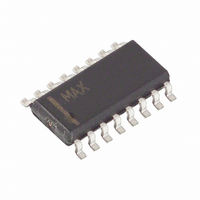DS3991Z+PP Maxim Integrated Products, DS3991Z+PP Datasheet - Page 9

DS3991Z+PP
Manufacturer Part Number
DS3991Z+PP
Description
IC CTRLR CCFL PUSH-PULL 16-SOIC
Manufacturer
Maxim Integrated Products
Type
CCFL Controllerr
Datasheet
1.DS3991ZHB.pdf
(16 pages)
Specifications of DS3991Z+PP
Frequency
40 ~ 80 kHz
Current - Supply
5mA
Voltage - Supply
4.5 V ~ 5.5 V
Operating Temperature
-40°C ~ 85°C
Package / Case
16-SOIC (3.9mm Width)
Lead Free Status / RoHS Status
Lead free / RoHS Compliant
Current - Output
-
Lead Free Status / Rohs Status
Details
If the PWM_EN pin is tied high, the digital control
method is enabled and an external PWM signal
between 80Hz and 300Hz is applied at the POSC/PWM
pin to set the brightness of the lamp. In the digital con-
trol method, the SLOPE and BRIGHT pins are not used.
On lamp strike, the DS3991 boosts the normal operating
lamp frequency by 33%. This is done to increase the
voltage created and help ensure that the lamp strikes.
Once the controller detects that the lamp has struck, the
frequency is returned to the normal lamp frequency.
Both the lamp and DPWM frequencies are set using
external resistors. The resistance required for either fre-
quency can be determined using the following formula:
where K = 4000kΩ x kHz for lamp frequency calcula-
tions, K = 4kΩ x kHz for DPWM frequency calculations.
Example: Select the resistor values to configure the
DS3991 to have a 50kHz lamp frequency and a 160Hz
DPWM frequency. For the DPWM resistor calculation, K
= 4kΩ x kHz. For the lamp frequency resistor (R
calculation, K = 4000kΩ x kHz. The formula above can
now be used to calculate the resistor values for R
and R
Figure 1. Digital PWM Dimming and Soft-Start
(EITHER CREATED INSIDE THE DS3991 OR
Setting the Lamp and DPWM Frequencies Using
POSC
SOURCED AT THE POSC/PWM PIN)
BURST-DIMMING PWM SIGNAL
R
as follows:
LOSC
R
POSC
LAMP CURRENT
_______________________________________________________________________________________
R
=
OSC
=
4000k
0.160kHz
4k
50kHz
=
SOFT-START
f
OSC
K
kHz
kHz
= 25k
External Resistors
= 80k
80Hz TO 300Hz
Lamp Strike
LOSC
LOSC
Low-Cost CCFL Controller
)
The DS3991 has supply-voltage monitors (SVML and
SVMH) for the inverter’s DC supply (V
undervoltage lockout for the V
voltage levels are adequate for proper operation. The
inverter supply is monitored for overvoltage conditions
at the SVMH pin and undervoltage conditions at the
SVML pin. External resistor-dividers at each SVM input
feed into two comparators, both having 2V thresholds
(see Figure 2). Using the equation below to determine
the resistor values, the SVMH and SVML trip points
(V
the inverter supply voltage rises above or drops below
specified values.
Operating with the inverter supply at too low of a level can
prevent the transformer from reaching the strike voltage
and could potentially cause numerous other problems.
Operating with the inverter voltage at too high of a level
can be damaging to the inverter components. Proper use
of the SVMs can prevent these problems. If desired, the
high and/or low SVMs can be disabled by connecting the
SVMH pin to GND and the SVML pin to VCC.
The SVMH and SVML are high-impedance inputs and
noise on the inverter supply can cause the monitors to
inadvertently trigger even though the inputs contain hys-
teresis. The user may wish to add a lowpass filter to
reduce the noise present at the SVMH and SVML inputs.
The V
(UVLO) that prevents operation when the DS3991 does
not have adequate voltage for its analog circuitry to
operate or to drive the external MOSFETs. The V
monitor features hysteresis to prevent V
TRIP
CC
) can be customized to shut off the inverter when
monitor is a 5V supply undervoltage lockout
V
TRIP
= 2.0
R
CC
1
Supply Monitoring
R
+ R
supply to ensure that
1
2
CC
INV
noise from
) and an
CC
9













